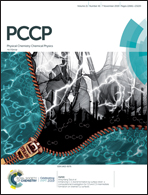Polymer spacer tunable Purcell-enhanced spontaneous emission in perovskite quantum dots coupled to plasmonic nanowire networks†
Abstract
Lead halide perovskite quantum dots (PQDs) have recently been proposed as a scalable and color-tunable quantum source, but their slow spontaneous emission creates a mismatch with high-speed nanophotonic devices. Here, we demonstrate fast and bright emission in PQD films coupled to silver nanowire networks (NWKs), in which polyvinyl alcohol (PVA) is used as a spacer to regulate the lossy characteristics of the plasmonic cavity. Compared with bare quartz, the PVA substrate shows a considerable enhancement effect on the apparent emission intensity, but a reduction in the emission rate of PQD excitons. The efficient NWK–PQD coupling generates an increase in the emission intensity of a factor of 6.0 (average 3.4) and simultaneously a 2.4-fold (average 1.9) enhancement in the emission rate. However, an opposite PVA spacer thickness dependence for Purcell factor and quantum yield is observed, indicating that the fast and bright emission would be a trade-off between the Purcell-enhanced radiative rate and large metal loss. These results are believed to provide fundamental guidance on plasmonic cavity design for perovskite-based nanophotonic devices.

- This article is part of the themed collection: 2019 PCCP HOT Articles


 Please wait while we load your content...
Please wait while we load your content...